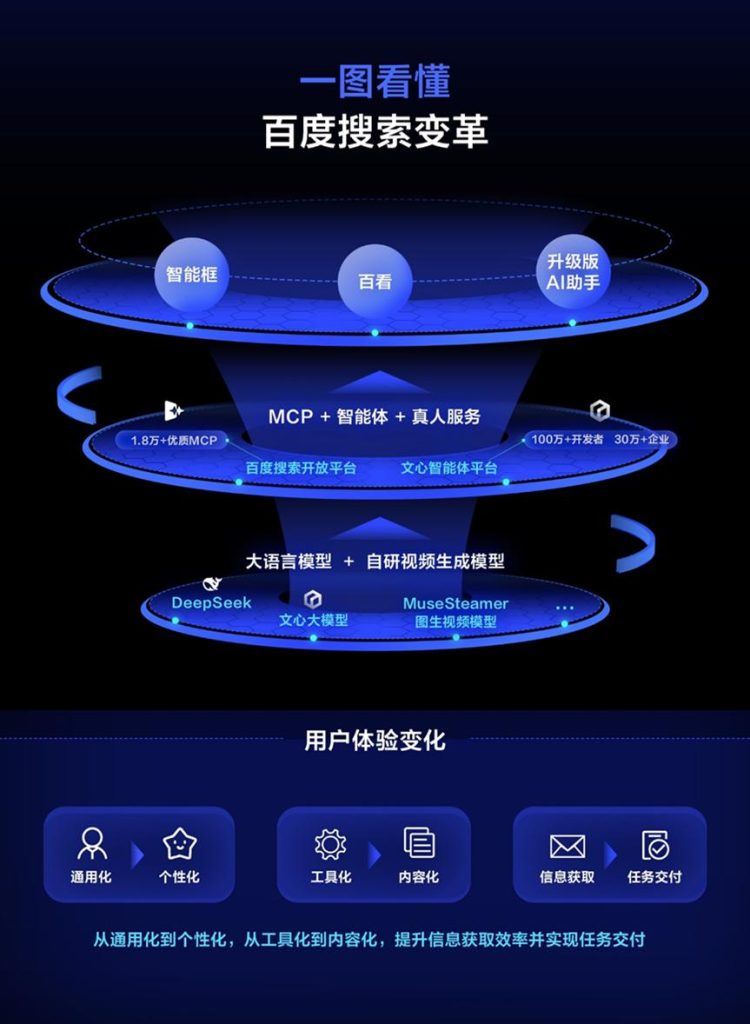
Positive Reviews: Baidu’s Upgrade of the “Intelligent Search Box” Redefines the Super Entrance in the AI Era
In today’s era where AI technology has deeply penetrated the Internet, the role of search engines is undergoing a qualitative change from being an “information carrier” to an “intelligent service hub.” Baidu’s upgrade of the search box to an “intelligent search box” and the construction of a new ecological architecture of “bottom layer – middle layer – upper layer” not only represent a revolutionary transformation of its own product form but also demonstrate its strategic foresight in competing for the super entrance in the AI era.
I. Technical Integration and Ecological Construction: Connecting the Entire Link from “Model” to “Service”
Baidu’s upgrade is not a simple addition of functions but a systematic reconstruction based on the technical foundation. At the bottom layer, with the Wenxin Big Model as the core, it integrates the video generation model Muse Steamer and external excellent models (such as DeepSeek), solving the “supply problem” of AI capabilities; in the middle layer, through the MCP (Multimodal Control Protocol), it connects Agent tools with real – human services, transforming the “cognitive ability” of the big model into “executive ability”; at the upper layer, products such as the intelligent search box, Baikan, and AI assistants directly reach users, completing the last – mile implementation from “technology” to “experience.” This three – layer architecture of “model + tool + service” essentially upgrades the search from a single information retrieval tool to an “AI operating system” capable of handling complex tasks.
Taking the MCP ecosystem as an example, Baidu’s platform has included more than 18,000 MCP services, covering scenarios such as life, finance, and e – commerce. This means that users can not only “ask for answers” but also “give instructions” through the search box – for example, querying product inventory, invoking payment interfaces to place orders, and even generating creative videos and sharing them directly. This breakthrough in the “task – completion” ability is exactly the core demand upgrade of users for search in the AI era. As Zhao Shiqi, the vice – president of Baidu, said, “Forget the old search form,” which essentially means forgetting the traditional output of “link lists” and turning to the new form of “service delivery.”
II. Multimodal Interaction and Scenario Coverage: Accurately Meeting the Changing User Demands in the AI Era
The core of traditional search is “deterministic demands”: users input clear questions and obtain structured answers. However, in the AI era, users’ demands are more “vague” and “exploratory” – for example, users may only take a photo of their nails and hope to know the common types; or input “handmade tutorial for best – friend bracelets” and expect to get video step – by – step guidance. Baidu’s upgrade of the intelligent search box accurately responds to this change: it supports multimodal input such as text of over a thousand characters, dialect recognition (Cantonese, Sichuanese, etc.), and picture/video understanding, and combines the multimodal output (mixed text, pictures, audio, and video) of the “Baikan” function to truly achieve “answering as the user asks.”
What’s more noteworthy is its ability to handle “non – text demands.” For example, the AI – generated camera understands users’ demands through pictures (such as travel guides and electrical fault solutions) and provides structured content; the video generation model Muse Steamer supports the generation of 10 – second 1080P high – definition long videos (the Turbo version only takes 2 minutes to generate a 5 – second video), with a cost lower than the industry average. These capabilities not only cover users’ “information acquisition” demands but also extend to the “content creation” scenario – users can generate a three – minute creative video with just one sentence and support shot editing, which is a key tool for ordinary users and small and medium – sized creators to lower the threshold of content production.
III. Dual – Wheel Drive of Traffic and Technology: Consolidating the Status of the Super Entrance
Against the backdrop of AI native applications (such as Kimi and DeepSeek) trying to compete for the “new super entrance,” Baidu’s advantage lies in the dual barriers of “existing traffic” and “technical accumulation.” As of the first quarter of 2025, the monthly active users of the Baidu App reached 724 million, which is a user base that any AI native application can hardly reach in the short term. Since 2022, Baidu has continuously iterated the Wenxin Big Model, was the first to support the access of external excellent models (such as DeepSeek), and connected developers and tools through the MCP ecosystem, forming a closed – loop of “model – tool – user.” This combination of “large traffic + strong technology + open ecosystem” gives it a first – mover advantage in the competition for the AI entrance.
Compared with Google’s AI search upgrade (supporting complex data visualization, proxy checkout, etc.), Baidu’s path emphasizes more on “localized scenario adaptation” – dialect recognition, life services (such as handmade tutorials and couplet generation), support for small and medium – sized creators, etc., which are more in line with the actual needs of domestic users. As industry insiders said, “The next super product needs to change the way users interact with the Internet,” and Baidu’s upgrade of the intelligent search box is a concrete practice of this change.
Negative Reviews: The Leap from “Search” to “Ecology” Still Needs to Face Multiple Challenges
Although Baidu’s upgrade shows strategic ambition, there are still multiple real – world obstacles to overcome from the “technical blueprint” to “users’ acceptance.” There are uncertainties in its ecological collaboration, user habit migration, competitive pressure, and commercialization path.
I. The Complexity of Ecological Collaboration: The Quality of MCP Services and the Enthusiasm of Developers Remain to Be Verified
The MCP ecosystem in the middle layer is the “capability engine” of Baidu’s intelligent search box, but the prosperity of the ecosystem depends on two key factors: one is the quality and diversity of MCP services, and the other is the enthusiasm of developers to participate. Currently, Baidu’s platform has included more than 18,000 MCP services, but some services may have the problem of being “usable but not high – quality” – for example, can the MCP in the e – commerce scenario accurately call inventory data? Can the MCP in the financial scenario guarantee user privacy? If users leave due to poor service quality, it may have a negative impact on the reputation of the intelligent search box.
In addition, the motivation of small and medium – sized developers may be limited. The MCP essentially means “working for Baidu’s ecosystem.” Developers need to rely on Baidu’s traffic distribution to acquire users. If the revenue – sharing mechanism is not transparent or the revenue is insufficient, high – quality services may flow to other platforms (such as ByteDance’s AI tool ecosystem). How to balance “openness” and “control” is a key challenge for Baidu’s ecological operation.
II. The Difficulty of User Habit Migration: The Cognitive Gap from “Passive Retrieval” to “Active Interaction”
The core habit of traditional search users is “quick and straightforward” – input keywords and quickly obtain results. The intelligent search box requires users to adapt to “multimodal input” (such as taking photos and long – text descriptions), “vague demand expression” (such as “help me write a five – character couplet”) and even “task instructions” (such as “generate a travel video”). This change from “passive retrieval” to “active interaction” may cause some users to leave due to the complex operation.
For example, the news mentioned that “even ordinary people who don’t know how to write prompts can quickly get started,” but in reality, users may need to learn how to describe their demands in natural language (such as “how many common types of nails are there”) or understand the multimodal output logic of “Baikan” (when to choose text and when to choose video). If Baidu’s guidance design (such as prompt tabs and examples) is not intuitive enough, it may lead to a decline in user experience.
III. Competitive Pressure: Being Caught between AI Native Applications and Super Apps
Baidu faces competition not only from traditional search engines (such as Google) but also from AI native applications (such as Kimi and DeepSeek) and Internet super apps (such as WeChat and Douyin). AI native applications attract users with their “lightweight and vertical” features (such as the model capabilities of DeepSeek), while super apps compete for users’ time through “scenario integration” (such as WeChat’s “Search” + mini – programs and Douyin’s “Search + content recommendation”). Although Baidu’s intelligent search box emphasizes “multimodality,” it needs to compete with these opponents in terms of “content richness” (such as the quantity and quality of videos) and “service closed – loop” (such as directly jumping to e – commerce or mini – programs). If Baidu’s “Baikan” content ecosystem (such as PGC and UGC) fails to enrich quickly, it may be difficult to retain users.
IV. The Balance between Technical Iteration and Commercialization: Can High – Investment Be Transformed into Sustainable Revenue?
Baidu’s upgrade requires a huge technical investment – self – developed video generation model Muse Steamer, continuous iteration of the Wenxin Big Model, maintenance of the MCP ecosystem, etc., all of which require long – term capital and computing power support. However, the commercialization path is not clear: is it through advertising (such as service recommendations in search results), value – added services (such as paid functions for video generation), or ecological revenue – sharing (such as the commission of MCP services)?
If it relies too much on advertising, it may damage the user experience (such as inserting hard – core ads in the multimodal result page); if the pricing of value – added services is too high, it may suppress users’ willingness to use; if the ecological revenue – sharing ratio is too low, it may be difficult to motivate developers. How to find a balance among “user experience,” “developer revenue,” and “self – profit” is the core problem that Baidu needs to solve in the future.
Advice for Entrepreneurs: Extract the Survival Rules in the AI Era from Baidu’s Upgrade
Baidu’s upgrade of the “intelligent search box” is essentially a deep integration of AI technology, user demands, and ecological capabilities. For entrepreneurs, the following key insights can be extracted:
I. Focus on “Scenario – Based Demands” and Use Multimodal Capabilities to Solve Users’ “Vague Pain Points”
In the AI era, users’ demands are more vague (such as “want to do handicrafts but don’t know where to start”). Entrepreneurs need to break out of the thinking of “precise retrieval” and turn to “scenario – based services.” For example, for the “travel guide” scenario, image recognition (users take photos of scenic spots), voice interaction (users describe their demands), and video generation (outputting strategy videos) can be combined to provide a one – stop service of “input – understanding – execution.” Baidu’s multimodal input and output capabilities (text, pictures, videos) are exactly the embodiment of this logic. Entrepreneurs can learn from its “demand – acceptance” idea and use technology to solve users’ demands that are “hard to describe clearly.”
II. Build an “Open Ecosystem” and Connect External Resources through Tools and Services
Baidu’s MCP ecosystem proves that it is difficult to cover all scenarios with its own technology alone, and open cooperation is an inevitable choice. Entrepreneurs need to design “tool interfaces” or “protocol standards” to attract third – party developers to access (such as e – commerce data, payment tools, and professional knowledge bases), and upgrade their own products from a “function collection” to a “service platform.” For example, entrepreneurs doing vertical – field AI assistants can open APIs to allow industry service providers (such as legal consultation and medical diagnosis) to access, improving the product’s “task – completion” ability.
III. Pay Attention to “User Habit Cultivation” and Use Low – Threshold Design to Reduce the Cost of Use
Baidu reduces the threshold for users to use the intelligent search box through “prompt tabs” and “example guidance,” which is also important for entrepreneurs. Facing the new interaction methods in the AI era (such as multimodal input and natural – language instructions), entrepreneurs need to use “fool – proof design” (such as preset templates and voice – assisted input) to help users get started quickly. For example, entrepreneurs doing AI writing tools can provide scenario templates such as “Moments copywriting” and “resume optimization,” and users only need to fill in the blanks to generate content, avoiding the loss of users due to “not knowing how to write prompts.”
IV. Balance “Technical Investment” and “Commercialization Implementation” to Avoid Falling into the Trap of “Technology for Technology’s Sake”
Although Baidu’s upgrade is technologically impressive, it ultimately needs to be monetized through user payment or ecological realization. Entrepreneurs need to be vigilant against the risk of “over – pursuing technological leadership” while ignoring commercialization. For example, when developing a video generation model, they need to prioritize solving “cost” and “efficiency” (such as Baidu’s Muse Steamer’s 10 – second 1080P generation) instead of blindly pursuing “movie – level picture quality”; when accessing external services, they need to design a reasonable revenue – sharing mechanism (such as paying by effect) to ensure that both developers and themselves can make a profit.
V. Pay Attention to “Entrance Competition” and Bind Users’ Minds with “High – Frequency Scenarios”
Baidu consolidates its entrance status with the “high – frequency nature” of search (users use it multiple times a day). Entrepreneurs can learn from this logic and choose “high – frequency scenarios” (such as daily tools and social assistants) as the entry point, and bind users’ minds through continuous services. For example, entrepreneurs doing AI learning assistants can focus on high – frequency demands such as “daily homework tutoring” and “wrong – question sorting,” and gradually extend to low – frequency but high – value scenarios such as “exam planning” and “college application,” ultimately forming an “entrance – level” product.
Conclusion
Baidu’s upgrade of the “intelligent search box” is a “self – revolution” of search engines in the AI era. It not only shows the advantages of the giant in technical integration and ecological construction but also exposes the challenges in implementing from “technology” to “users.” For entrepreneurs, the key is to extract the underlying logic of “demand insight – technology adaptation – ecological collaboration” from this case and find their own survival and development paths in the competition for the entrance in the AI era.





